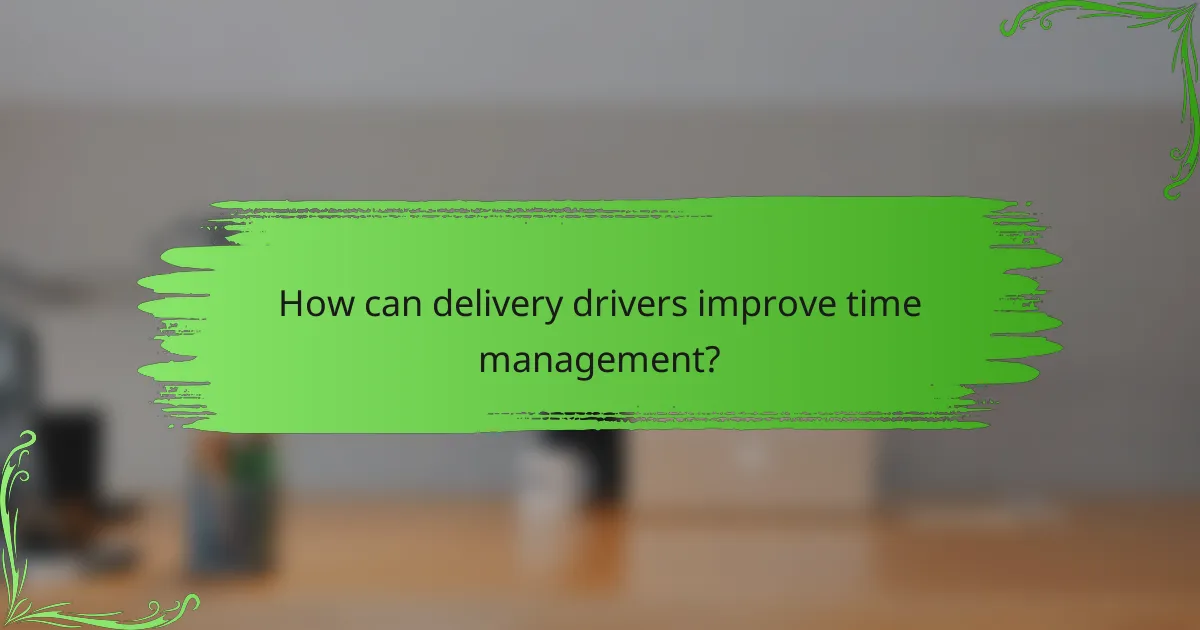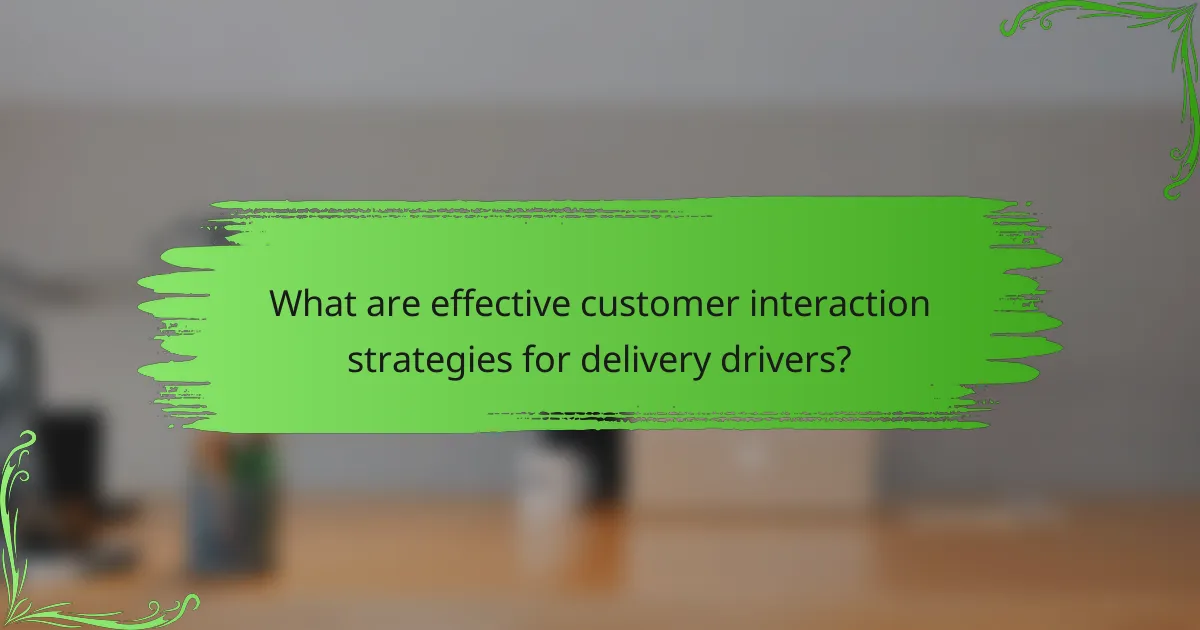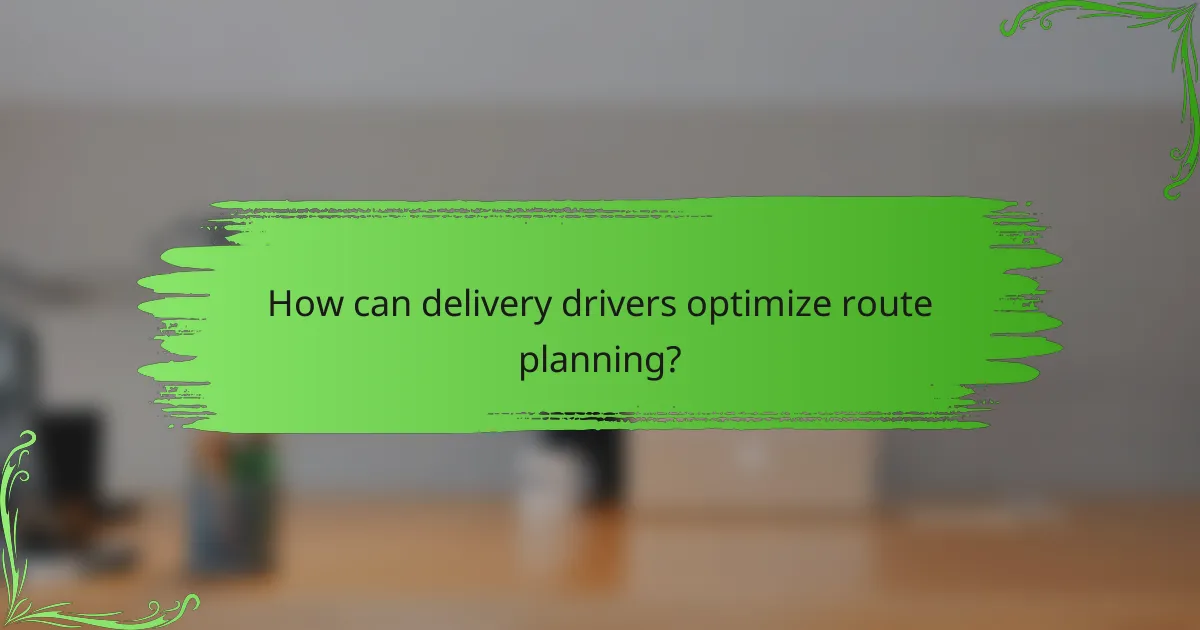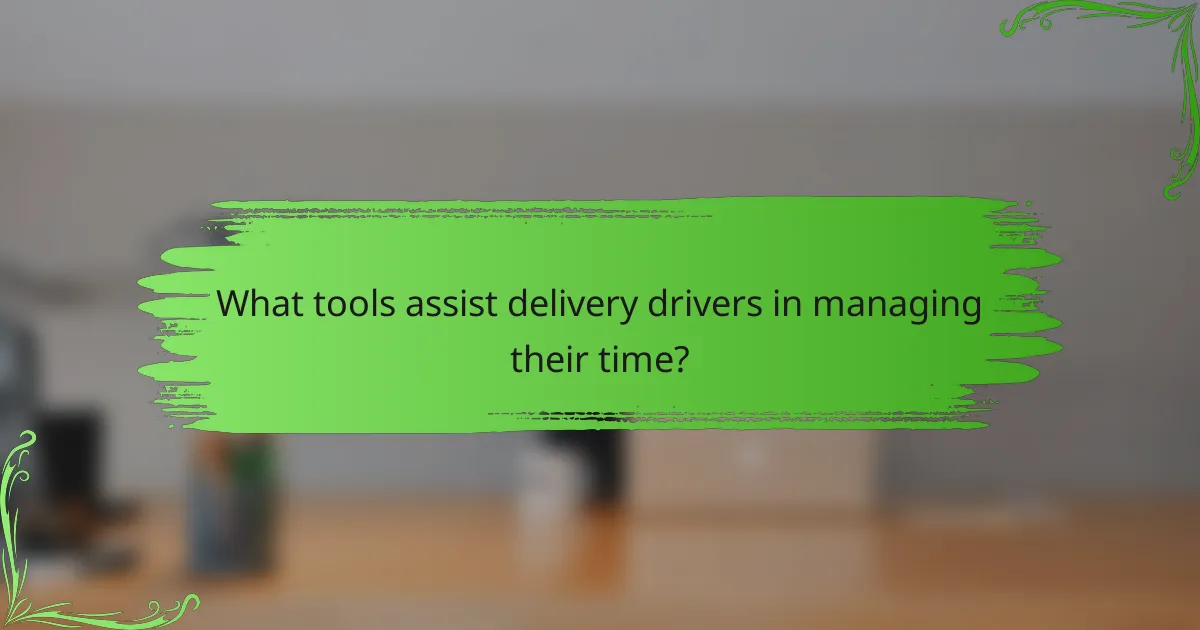Delivery drivers play a crucial role in ensuring timely and efficient service, which relies heavily on effective time management, customer interactions, and route planning. By employing structured techniques and leveraging technology, drivers can enhance their operational efficiency while fostering positive relationships with customers. Mastering these skills not only leads to improved satisfaction but also contributes to a more streamlined delivery process.

How can delivery drivers improve time management?
Delivery drivers can enhance their time management by adopting structured techniques and tools that streamline their daily operations. Effective time management not only boosts efficiency but also improves customer satisfaction and reduces stress.
Utilizing time-blocking techniques
Time-blocking involves dividing the day into specific segments dedicated to particular tasks, which helps drivers focus on one activity at a time. For example, a driver might allocate 9 AM to 10 AM for loading packages and 10 AM to 1 PM for deliveries. This method minimizes distractions and encourages a disciplined approach to completing tasks.
To implement time-blocking, drivers should assess their typical delivery routes and identify peak traffic times. By scheduling deliveries during off-peak hours, they can maximize efficiency and reduce delays.
Implementing digital scheduling tools
Digital scheduling tools can significantly enhance a driver’s ability to manage their time effectively. Applications like Google Calendar or specialized delivery software allow drivers to plan their routes, set reminders, and track their progress in real-time. These tools can help in visualizing the day’s tasks and adjusting plans as needed.
Drivers should choose tools that integrate with their navigation apps to optimize routes based on current traffic conditions. This integration can save valuable minutes and reduce fuel costs.
Prioritizing deliveries based on urgency
Prioritizing deliveries is crucial for effective time management. Drivers should assess which deliveries are time-sensitive and organize their routes accordingly. For instance, urgent deliveries should be completed first, especially if they involve perishable goods or critical services.
To prioritize effectively, drivers can categorize deliveries into tiers based on urgency and distance. This approach ensures that they meet customer expectations while maintaining a steady workflow.
Setting realistic time estimates
Setting realistic time estimates for each delivery is essential for maintaining an efficient schedule. Drivers should consider factors such as distance, traffic patterns, and delivery windows when estimating how long each task will take. A good rule of thumb is to add a buffer of 10-15% to account for unforeseen delays.
Regularly reviewing past delivery times can help drivers refine their estimates over time. By analyzing patterns and adjusting accordingly, they can improve their accuracy and reliability in meeting delivery commitments.

What are effective customer interaction strategies for delivery drivers?
Effective customer interaction strategies for delivery drivers focus on clear communication, active listening, and managing expectations. These skills help ensure a positive experience for customers and can lead to higher satisfaction and repeat business.
Practicing active listening skills
Active listening involves fully concentrating on what the customer is saying and responding thoughtfully. This means acknowledging their concerns and asking clarifying questions when necessary. For example, if a customer expresses a concern about their delivery time, a driver can paraphrase their concern to show understanding.
By demonstrating that you are engaged, you build trust and rapport, which can enhance the overall delivery experience. Remember to maintain eye contact and nod to show you are listening, even if the interaction is brief.
Using friendly and professional communication
Maintaining a friendly yet professional tone is crucial in customer interactions. Using polite greetings and expressing gratitude can set a positive tone for the conversation. For instance, saying “Thank you for your patience” can make customers feel valued.
Additionally, using clear language and avoiding jargon helps ensure that customers understand any necessary information about their delivery. A warm smile and a friendly demeanor can significantly enhance the interaction, even if it’s just a quick drop-off.
Managing customer expectations
Setting realistic expectations is key to customer satisfaction. Inform customers about estimated delivery times and any potential delays as soon as possible. For example, if traffic is heavy, let them know you might be running late.
Providing updates during the delivery process can also help manage expectations. A simple message indicating that you are on your way can reassure customers and reduce anxiety about their order.
Handling complaints gracefully
When faced with complaints, it’s essential to remain calm and professional. Listen to the customer’s issue without interrupting, and express empathy for their situation. Acknowledging their feelings can help diffuse tension and show that you care.
After listening, offer a solution if possible, or explain the next steps you will take to address their concern. For example, if a delivery is late, you might offer a discount on their next order as a goodwill gesture. Always thank them for bringing the issue to your attention, as this can turn a negative experience into a positive one.

How can delivery drivers optimize route planning?
Delivery drivers can optimize route planning by utilizing technology and strategic analysis to minimize travel time and enhance efficiency. Effective route planning considers factors like traffic, delivery zones, and real-time updates to ensure timely deliveries.
Using GPS navigation apps like Waze
GPS navigation apps, such as Waze, provide real-time traffic information and route suggestions that can significantly improve delivery efficiency. These apps use crowd-sourced data to identify the fastest routes, helping drivers avoid congested areas and delays.
To maximize benefits, drivers should regularly check for app updates and familiarize themselves with the app’s features, such as alternate route suggestions and estimated arrival times. Utilizing these tools can save drivers valuable minutes on their routes.
Analyzing traffic patterns
Understanding traffic patterns is crucial for effective route planning. Drivers should analyze peak traffic times in their delivery areas to avoid delays, especially during rush hours or local events that may cause congestion.
By keeping a log of traffic conditions over time, drivers can identify trends and adjust their schedules accordingly. For instance, if certain routes are consistently slower during specific times, planning deliveries outside these hours can enhance efficiency.
Planning routes based on delivery zones
Organizing deliveries by zones can streamline the route planning process. By grouping deliveries that are geographically close, drivers can minimize travel distances and reduce fuel costs.
Creating a zone map can help visualize delivery areas and prioritize routes. This method not only saves time but also allows for more efficient use of resources, especially during busy periods.
Incorporating real-time updates
Incorporating real-time updates into route planning is essential for adapting to changing conditions. Drivers should stay informed about road closures, accidents, or weather changes that could impact their routes.
Using apps that provide live updates can help drivers make quick decisions on rerouting when necessary. This flexibility can significantly improve delivery times and customer satisfaction by ensuring timely arrivals despite unforeseen circumstances.

What tools assist delivery drivers in managing their time?
Delivery drivers can enhance their time management through various tools designed for efficiency. Key resources include delivery management software, mobile apps for time tracking, and route optimization tools, each serving distinct purposes to streamline operations.
Delivery management software like Onfleet
Delivery management software, such as Onfleet, helps drivers coordinate their deliveries effectively. These platforms provide features like real-time tracking, automated notifications, and performance analytics, which can significantly reduce delays and improve customer satisfaction.
When selecting delivery management software, consider factors like user-friendliness, integration capabilities with existing systems, and customer support. Many services offer free trials, allowing drivers to assess functionality before committing.
Mobile apps for time tracking
Mobile apps for time tracking enable delivery drivers to monitor their working hours and optimize their schedules. These applications can log time spent on deliveries, breaks, and other activities, helping drivers identify areas for improvement.
Look for apps that offer features like reminders, reporting, and integration with payroll systems. Popular options include Toggl and Clockify, which can help drivers stay organized and ensure they are compensated accurately for their time.
Route optimization tools
Route optimization tools assist delivery drivers in planning the most efficient routes, saving both time and fuel. These tools analyze traffic patterns, road conditions, and delivery locations to suggest the quickest paths.
Using route optimization software can lead to significant time savings, often reducing delivery times by 10-30%. Popular tools include Google Maps and Waze, which provide real-time updates and can adjust routes based on current traffic conditions.

What criteria should delivery drivers consider for customer interactions?
Delivery drivers should prioritize clear communication, professionalism, and empathy during customer interactions. Understanding customer needs and preferences can significantly enhance the delivery experience and foster positive relationships.
Understanding customer demographics
Recognizing customer demographics is essential for tailoring interactions effectively. Factors such as age, cultural background, and location can influence how customers prefer to communicate and receive their deliveries. For instance, younger customers may appreciate digital communication, while older clients might prefer a more personal touch.
Drivers can benefit from familiarizing themselves with common demographic trends in their delivery area. This knowledge can help in anticipating customer expectations and adjusting their approach accordingly, ensuring a smoother interaction.
Assessing delivery context and location
The context of each delivery plays a crucial role in shaping customer interactions. Factors such as the time of day, weather conditions, and the type of delivery (e.g., food, packages) can affect how customers respond. For example, delivering during peak hours may require more patience and understanding due to potential delays.
Additionally, being aware of the delivery location can help drivers prepare for specific challenges. Urban areas may have different parking regulations and higher foot traffic compared to suburban regions. Drivers should always stay informed about local regulations and adapt their strategies to ensure timely and efficient deliveries.

